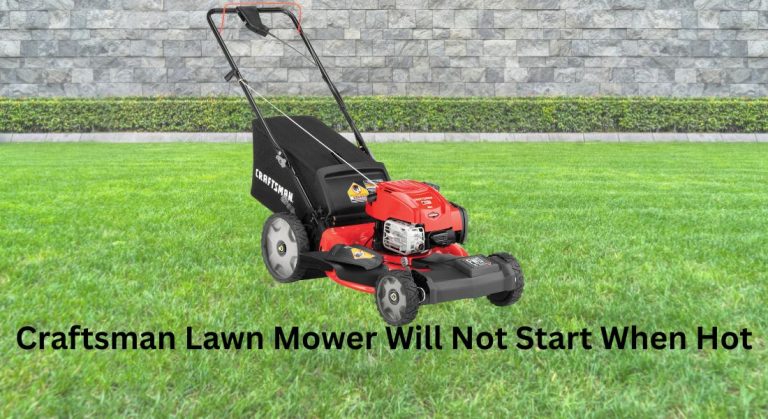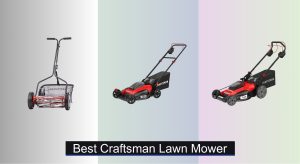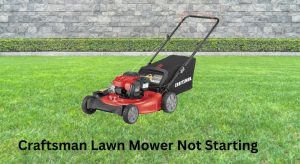Nothing is more frustrating than mowing halfway through your yard only to find your Craftsman lawn mower will not start when hot. The quick fix to try first: open the fuel cap for 30 seconds to relieve vapor lock, then pull the starter with the choke off and throttle at fast. If it fires, you’re dealing with heat-related fuel delivery or venting issues.
In this comprehensive guide, you’ll learn every common cause of hot-start problems—vapor lock, weak ignition coils, carburetor flooding, and compression loss—and how to fix each one step by step. We’ll cover both push mowers and Craftsman riders with Briggs & Stratton, Kohler, and Honda engines, with simple and advanced solutions, testing tips, and prevention advice to get your mower running reliably again.
Common Causes of a Craftsman Lawn Mower Not Starting When Hot

- Vapor lock from a blocked fuel cap vent or fuel line routing near hot engine parts
- Failing ignition coil (magneto) that loses spark when hot
- Carburetor flooding or heat soak causing a rich condition
- Sticking choke or auto-choke misadjustment
- Faulty spark plug or heat range mismatch
- Valve lash out of spec causing low compression when hot
- Weak fuel pump (on riders) or degraded fuel line collapsing when warm
- Old ethanol fuel causing boiling, varnish, or gumming
- Dirty air filter restricting airflow when hot
- Safety switches (seat, brake, blade) failing as they warm up (riders)
How to Fix a Craftsman Lawn Mower That Won’t Start When Hot
Method 1: Quick Checks and Vapor Lock Relief
This is the fastest way to diagnose fuel vaporization and simple venting issues.
Diagnosing the Issue
- Symptoms: Mower runs fine cold, stalls or won’t restart after 10–30 minutes, then restarts after cooling.
- Often accompanied by a faint fuel smell or a “hollow” sound when pulling the starter.
Fix Steps
- Relieve tank pressure
– Turn off engine (if running). Open the fuel cap slowly. Listen for a hiss.
– Leave cap loose for 30–60 seconds to vent. - Attempt a hot start
– Set throttle to fast, choke OFF (hot engine doesn’t need choke).
– Pull starter or turn key. If it starts, replace or clean the fuel cap. - Inspect the fuel cap vent
– Blow through the cap vents. If blocked, clean with compressed air or replace the cap. - Reroute/insulate fuel line (if close to the muffler)
– Keep lines away from hot surfaces. Add a small heat sleeve or reflective tape. - Use fresh fuel
– Drain old gas and fill with fresh, ethanol-free fuel if available, or E10 with stabilizer.
Testing
- Mow for 20 minutes, shut off, and attempt a restart with choke off.
- If the problem disappears, the issue was venting/vapor lock.
Method 2: Restore Hot Spark – Ignition Coil and Plug
Ignition coils can fail when hot, losing spark until they cool.
Diagnosing the Issue
- When hot, engine cranks strongly but no fire. After 10–30 minutes, starts again.
- Spark is weak or absent when tested immediately after shutoff.
Fix Steps
- Test for spark when hot
– Remove spark plug, reconnect wire, ground plug threads to engine, and crank.
– Look for a strong blue spark. Weak or no spark suggests a failing coil or plug. - Replace the spark plug
– Use OEM spec: typically NGK BPR6ES, Champion RJ19LM, J19LM, or per engine manual.
– Set gap to 0.028–0.030 in (0.7–0.76 mm). - Inspect the ignition coil (armature)
– Check coil air gap: 0.010–0.014 in (0.25–0.36 mm) using a business card or feeler gauge.
– Inspect coil wire for cracks; ensure kill wire terminal is clean and tight. - Perform hot coil test
– With the engine hot and failing to start, disconnect the small kill wire from the coil and try to start. If it now starts, you have a shorting kill circuit/safety switch issue. If still no start and no spark, the coil is bad. - Replace the ignition coil if needed
– Use OEM or high-quality aftermarket coil for your engine model (Briggs: 593872/590454; Kohler/Honda varies by model). Torque coil bolts per manual (~30–40 in-lb).
Testing
- Run 30 minutes, shut off, hot restart. Confirm strong spark and reliable starts.
Method 3: Fix Carburetor Flooding and Heat Soak
Heat can expand fuel and cause a rich/flooded condition, especially with dirty carbs or sticky needle valves.
Diagnosing the Issue
- Hot engine smells like fuel; plug is wet after failed hot start.
- Starts when you hold throttle open and air filter removed.
- Primer bulb may be soft or collapsing.
Fix Steps
- Try the de-flood procedure
– Choke off, throttle full, pull starter 5–6 times to clear excess fuel.
– If it fires briefly, you’re likely flooded. - Clean or rebuild the carburetor
– Shut fuel valve or clamp line; remove carb.
– Disassemble bowl, float, needle, and jets. Clean all passages with carb cleaner and compressed air.
– Replace needle/seat and bowl gasket; install a new main jet/emulsion tube if corroded. - Check float height and needle seating
– Float should sit level when inverted; replace if fuel-logged. - Inspect choke plate and linkage
– Ensure choke fully opens when hot. Adjust auto-choke thermostatic spring (if equipped) per manual. - Replace the air filter
– A clogged filter can cause rich running when hot. Replace foam/paper elements as needed. - Add a fuel shutoff valve (if not present)
– Helps prevent heat soak flooding after shutdown: close valve 30–60 seconds before stopping to run bowl low.
Testing
- Hot restart with choke off should be immediate. If it still floods, verify fuel level in bowl and needle sealing.
Method 4: Address Low Hot Compression (Valve Lash and Head Gasket)
As engines warm, valve clearance can tighten and compression can drop, making hot starts difficult.
Diagnosing the Issue
- Pull cord becomes unusually easy when hot; engine spins fast but won’t catch.
- Backfiring through carb or muffler.
- On OHV engines, valve lash is out of spec or auto-decompression isn’t working.
Fix Steps
- Check and adjust valve lash (OHV engines)
– Remove valve cover. Rotate engine to compression stroke TDC, then slightly past to close ACR.
– Typical clearances: Intake 0.004–0.006 in, Exhaust 0.006–0.008 in (check your engine spec).
– Loosen rocker nut, adjust with feeler gauge, and retighten.
– Replace valve cover gasket if needed. - Inspect head gasket (Briggs Intek riders are prone)
– Look for oil blow-by, hissing, or soot near head. Compression test can help (>90 psi typical).
– Replace head gasket; torque head bolts in sequence to spec. - Check for worn starter or battery (riders)
– Hot engine needs good cranking speed. Clean battery terminals; test battery (≥12.6V resting). Replace weak starter solenoid if sluggish.
Testing
- After adjustment, the engine should crank evenly and fire quickly when hot.
Method 5: Safety Switches and Electrical Shorts (Riding Mowers)
Heat and vibration can expose weak safety circuits.
Diagnosing the Issue
- Starts fine cold. After mowing, no crank or no spark until cooled.
- Wiggle seat, PTO, or brake pedals changes symptoms.
Fix Steps
- Inspect safety switches
– Seat, brake, clutch, and PTO switches: ensure firm activation and clean connectors. - Test kill circuit
– With key on, measure continuity to ground on the coil kill wire when switches are in RUN. Should be open. If you see intermittent ground when hot, a switch or wire is shorting. - Check harness routing
– Keep wires away from the muffler and moving parts; repair melted insulation. - Replace suspect switch
– Many Craftsman riders use simple plunger or lever micro-switches—cheap and easy to swap.
Testing
- Run for 20–30 minutes, shut down, and attempt hot restarts repeatedly. Confirm consistent crank and spark.
Prevention Tips and Maintenance Advice
- Use fresh fuel and stabilizer; avoid fuel older than 30 days.
- Replace the fuel cap if venting is weak; clean it annually.
- Keep fuel lines away from the muffler; add heat sleeves if needed.
- Service the air filter every 25 hours; replace paper filters yearly.
- Replace spark plug every season or 100 hours.
- Clean cooling fins and shrouds so the engine runs cooler.
- Adjust valve lash annually on OHV engines.
- On riders, keep electrical connectors clean and protected with dielectric grease.
Pro Tips
- Hot-start technique: choke off, throttle fast, and crack the throttle slightly on manual controls.
- If you smell raw fuel after shutdown, open the throttle and pull with no choke to clear flooding.
- For ethanol fuel areas, use fuel stabilizer with vapor-lock inhibitors and store fuel in a shaded, cool place.
- Install an inline fuel shutoff valve and run the carb near-empty before parking on hot days to reduce heat soak.
- Keep debris away from the engine shroud and muffler—heat retention worsens hot-start issues.
- When replacing a coil, always set the air gap with a business card evenly across the flywheel magnets.
- Don’t overtighten the fuel cap; some designs need a slight vent clearance to function.
When to Call a Professional
- You have no spark when hot even after new plug and coil—may indicate flywheel magnet or wiring faults.
- Persistent flooding after a carb rebuild—possible warped carb body or intake leak.
- Low compression or suspected head gasket failure—requires torque sequence and precision.
- Electrical issues on riders where multiple safety switches and interlocks are involved.
- Repeated vapor lock on V-twin riders—may need rerouting fuel lines, adding heat shields, or replacing the fuel pump.
Typical costs:
– Spark plug: $4–$10
– Fuel cap: $10–$20
– Ignition coil: $25–$60 (single cylinder), $60–$120 (V-twin)
– Carburetor kit/replacement: $15–$90
– Valve adjustment service: $80–$150
– Head gasket replacement: $120–$300
Warranty notes:
– Newer Craftsman models may have engine warranties separately through Briggs & Stratton, Kohler, or Honda. Avoid modifications that could void coverage; document maintenance.
FAQ
Q: Why does my Craftsman mower start cold but not hot?
A: Heat reveals weak components and causes fuel to vaporize. The most common culprits are a failing ignition coil, a blocked fuel cap vent causing vapor lock, carburetor flooding from heat soak, or tight valve lash reducing hot compression.
Q: How can I tell if vapor lock is my problem?
A: Loosen the fuel cap when the hot no-start occurs. If it starts right away, the vent is blocked. Also check if the fuel line is routed near the muffler—rerouting or insulating the line often fixes it.
Q: Should I use the choke for hot starts?
A: No. Using choke on a hot engine often floods it. For hot starts, set throttle to fast, choke off, and pull/turn key. If flooded, open throttle fully and crank to clear.
Q: How do I test the ignition coil when it’s hot?
A: Immediately after the stall, remove the spark plug, ground it to the engine, and check for a strong blue spark while cranking. No spark when hot but spark when cool points to a failing coil. Disconnect the coil’s kill wire to rule out safety circuit shorts.
Q: Can old gasoline cause hot starting problems?
A: Yes. Ethanol-blended fuel absorbs water, boils more readily, and can varnish jets. Drain old fuel, clean the carb, and use fresh fuel with stabilizer. Ethanol-free gas often improves hot restarts.
Q: What’s the right spark plug for my Craftsman mower?
A: It depends on the engine. Common options include NGK BPR6ES, Champion RJ19LM/J19LM, or equivalent. Check your engine model and set gap to 0.028–0.030 in.
Q: My riding mower cranks slow when hot—what should I check?
A: Test battery voltage (≥12.6V rested), clean terminals, inspect the starter and solenoid, and verify valve lash. Tight exhaust valves or a failing starter can cause hot slow cranking.
Q: How often should I adjust valve lash?
A: Check annually or every 100 hours on OHV engines. Heat and wear can tighten lash, reducing compression and making hot starts difficult.
Alternative Solutions
If you continue to experience hot-start vapor lock or heat soak on a rider, consider these upgrades:
| Solution | Pros | Cons | Best For |
|---|---|---|---|
| Ethanol-free fuel (E0) | Runs cooler, less vapor lock, stores better | Higher cost, limited availability | Hot climates and summer mowing |
| Fuel line heat sleeve | Reduces vapor lock, inexpensive | Requires minor rerouting | Lines near mufflers |
| Inline fuel shutoff valve | Prevents heat soak flooding | Must remember to use it | Carb flooding after shutdown |
| OEM fuel cap replacement | Restores proper venting | Minor cost | Blocked or weak cap vents |
| Complete carb replacement | Fast, often cheaper than rebuild | Aftermarket quality varies | Severely gummed or warped carbs |
Get Your Craftsman Mower Working Again
By now, you have multiple proven fixes to solve hot starting issues on a Craftsman lawn mower:
– Quick vapor lock checks: vent the tank, replace the fuel cap, reroute fuel lines
– Restore hot spark: new spark plug, correct coil gap, replace failing ignition coil
– Stop carb heat soak and flooding: clean/rebuild carb, ensure choke opens, fresh fuel
– Recover hot compression: adjust valve lash and inspect head gasket
– Verify rider safety circuits and wiring when heat-related electrical faults occur
Follow these steps in order, and you’ll eliminate the most likely causes first with minimal tools and cost. Don’t let a heat-soaked engine derail your mowing—tackle the quick fixes today, and your Craftsman lawn mower will not start when hot issue should be gone for good.
Have you fixed your hot-start problem? Share what worked for your model in the comments to help other owners. Found this helpful? Bookmark it for future tune-ups and seasonal maintenance.




